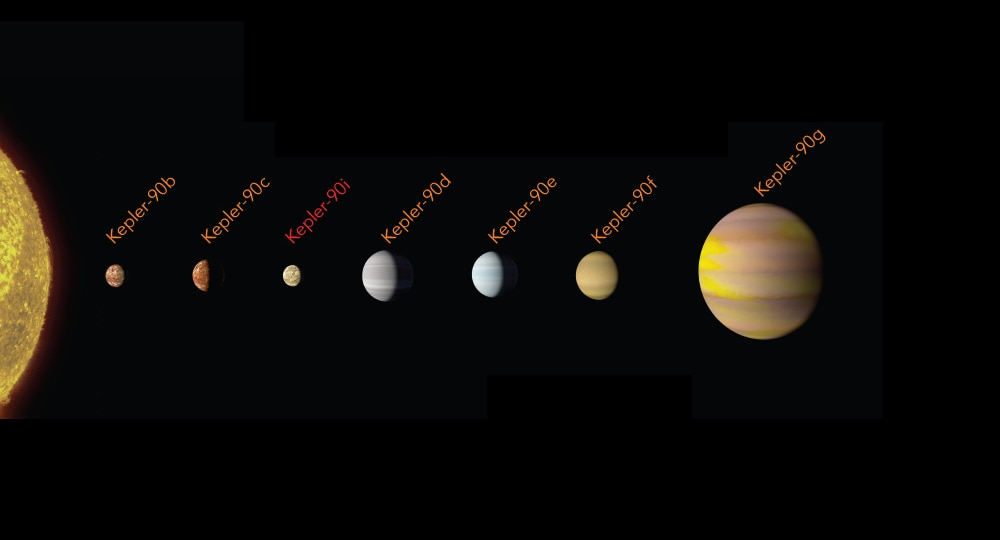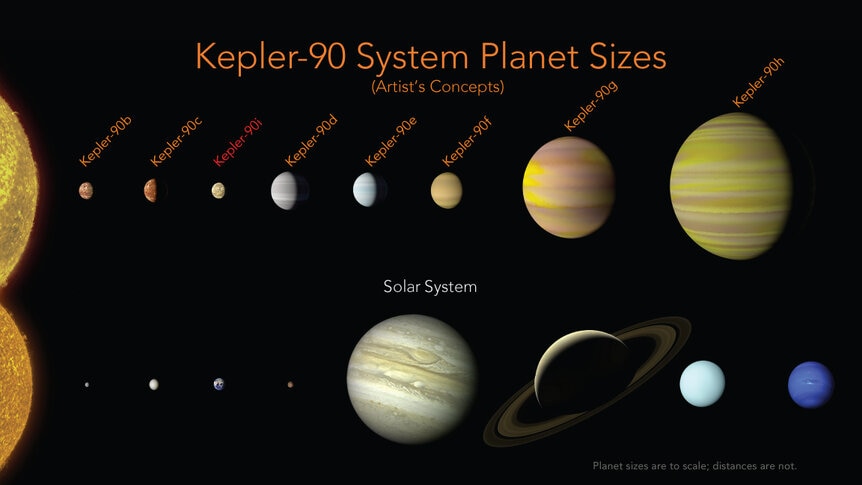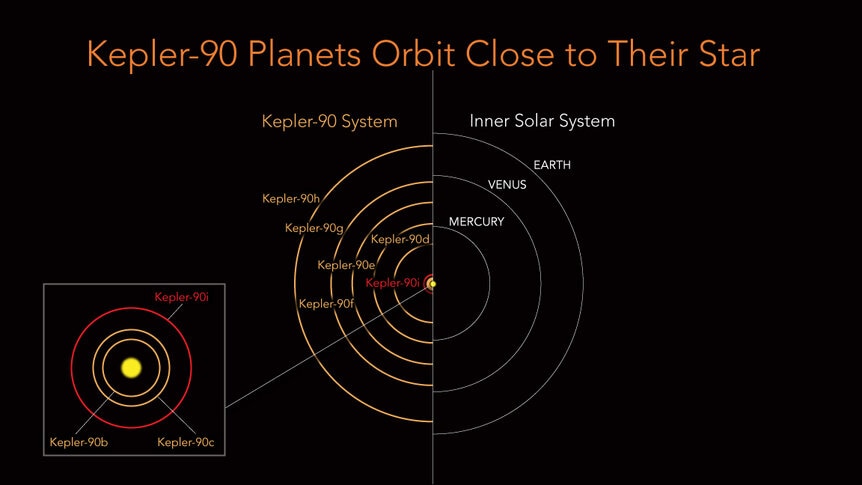Create a free profile to get unlimited access to exclusive videos, sweepstakes, and more!
And Kepler-90i makes eight: Another eight-planet solar system found!

A newly discovered planet orbiting a very Sun-like star about 2,500 light-years away is remarkable for two reasons: For one, it brings the total number of known planets in that system up to eight — the same as ours! And for another, it wasn't found by humans. No, I'm not saying aliens. It was found using a neural network, a kind of computer code that can be trained to look for patterns in data.
OK, first, the sciency stuff. The planet orbits the star Kepler-90, a star just a little bit bigger, more massive, and hotter than the Sun (for the serious astrogeeks, it's a G0V star). It's younger than the Sun, roughly 2 billion years old, but that's still considered mature; it's had plenty of time to settle down and just be a star doing its thing.
Kepler-90 is in the constellation of Cygnus, one of 150,000 stars sitting in a spot in the sky where the Kepler space telescope sat and stared for several years. The idea is that if a star has planets and we happen to see their orbits edge-on, the planets will block a wee fraction of the star once per orbit. This event is called a transit, and Kepler is really good at seeing them. It has found over 2,500 confirmed exoplanets this way!
Six planets were found orbiting Kepler-90 in 2013. Planets are named after their stars, followed by a lowercase letter starting at b, so these first planets were Kepler-90b through 90g. The seventh planet, 90h, was found later that year by Planet Hunters, a group of citizen scientists who go through Kepler data and look for the tiny dips in the stars' light.
The newest addition, Kepler-90i, fits right in with the others; it's the third planet out from the star. It's a super-Earth, about 1.3 times the diameter of our home world, but Earth-like it ain't. It's so close to the star — its orbit is just 14.4 days long! — that under reasonable assumptions for its characteristics it probably has a surface temperature of 430°C, making it closer to Venus in temperature than Earth.
This actually brings us to comparing the Kepler-90 system to our own. There are some striking similarities. For example, like our solar system, the inner planets are smaller and the outer planets bigger. That almost certainly has to do with environmental conditions when they formed. Planets form out of a disk of material swirling around their star, and the conditions in the disk change with distance. Close in it's hot and ice can't form, whereas farther out water ice is a major constituent. There's also just more material farther out, so planets can grow large.
But the differences here are probably more important. This is a mini-solar system: All eight planets orbit their star closer than Earth orbits the Sun! That's seriously tightly packed. Given what we know about system dynamics, it's unlikely they formed this way. Most likely most or all of them formed farther out, and gravitational interactions with the disk and each other made them migrate inward. Eventually the disk material ran out, and they settled into their current orbits.
The planets themselves are different than ours, too. The smallest is still bigger than Earth, and the two largest are about the size of Saturn and Jupiter. The inner six are therefore Super-Earths and may be more like Neptune, depending on whether they have thick atmospheres or not. That's not possible to determine just yet.
So that's all very cool and fun to think about, but I'm also impressed by how this planet was found. A neural net is a kind of sophisticated computer code that is used to interpret data. It gets "trained" using known data, and then based on that looks at unanalyzed data to look for patterns it can recognize. The astronomers in this case used a set of over 15,000 events. 3,600 were previously confirmed planetary transits, 9,600 were things that looked like transits but were due to other phenomena, and about 2,500 were just other events. In this way, they could train the software to spot the difference between real events, things that looked real, and things that may just be confusing. It did very well, getting a 96% accuracy in finding real signals!
They then let it loose on the Kepler data from 670 stars, each known to already host multiple planets. They also specifically had it look for weak signals, to see what it could find. It found quite a few potential candidates, but 9 of them had a probability of being real of 80% or higher. Of these, two withstood further scrutiny: Kepler-90i and Kepler-80g, a near-Earth-sized planet orbiting a dim red dwarf (M0V) about 1,100 light-years away.
Incidentally, there could be more planets orbiting Kepler-90. Because planets transit once per orbit it’s easier to find planets closer in; they transit more often and give us more data. A planet farther out might only transit once or twice a year, or even less (Jupiter, for example, would only transit as seen from another star once every 12 years).
Kepler-90 may be tied with us for number of planets (with a nod toward the idea that you can’t really define what a planet is) but it could pull ahead … unless astronomers find Planet 9 orbiting our own Sun first. It's a race!
This is pretty interesting. The data still needed a lot of human intervention, so running this on its own for the entire Kepler database of 150,000 stars would be difficult, to say the least. Also, the software can only find things it’s seen before in training, so it can't find really weird stuff with confidence. You still need humans for that. Our brains are good at picking funny-looking stuff out of noise (though in truth this can be confusing as well).
And hey, if you want to have a go at this yourself, the team will be releasing the code to the public, and it can be run on a standard desktop computer. The Kepler data are public, too! Maybe you can help find a planet …
… and in the meantime, you can sign up with Planet Hunters and look for planets with them, too. We've already found thousands, and many thousands more as yet undiscovered are likely in the data.
And just so's you know, there are hundreds of billions of planets in our galaxy alone. We're going to need a lot more data. And a lot more people to analyze them.




























